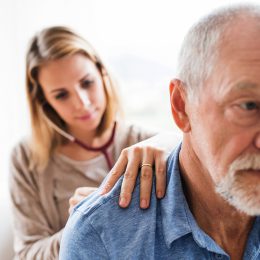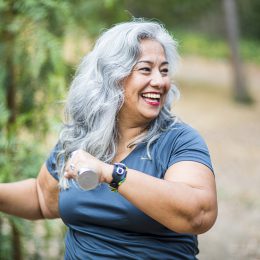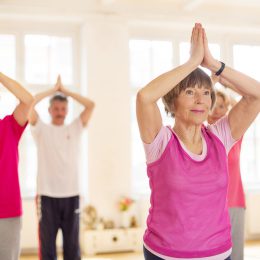How to Recover from a Stroke: A 5-Step Plan
Stroke rehab is hard work, but doable! Use these guidelines to maximize your efforts in the days, weeks, and months following a stroke.

When you hear “stroke,” what word comes to mind?
We’re willing to bet “beatable” wasn’t the first thing to pop into your head. But it’s time to flip the negativity script, say stroke experts.
With fast medical attention and a tailored rehabilitation plan, it’s possible to minimize permanent damage and come back strong. After all, more than 7 million Americans are stroke survivors, according to the American Stroke Association (ASA).
Early detection of stroke improves outcomes. A stroke happens when a blood clot cuts off blood supply to the brain, or if a blood vessel bursts and leaks blood into the brain. The faster you get help for symptoms of stroke, the greater your chances of survival and recovery, notes the ASA.
Rehabilitation is the other key, and a big part of that is learning new skills and routines to help you lead a full, active life. Follow these guidelines to maximize your recovery efforts.
Step #1: Start Moving and Meet Your Care Team
“Stroke rehab will start in the hospital—as soon as your condition has stabilized and you are medically cleared for activity, such as getting out of bed and on your feet,” says Shawn Kovach, PT, a physical therapist who works with stroke patients at Burke Rehabilitation Hospital in White Plains, New York.
The typical length of a hospital stay for stroke is four to seven days. During this time, your care team will work to figure out which parts of your brain have been impacted by the stroke, says Kovach.
You can expect to be evaluated by a number of pros, which many include:
- A physical therapist (PT) who will check your strength, muscle tone, flexibility, and ability to move and walk
- An occupational therapist who will assess your fine-motor skills that are crucial for activities of daily living, such as bathing and dressing
- A speech-language pathologist who will gauge your ability to swallow, your memory, and your speech processing and comprehension skills
These evaluations will help your care team develop a plan for you to follow after you leave the hospital. During this time, you’ll also want to check with your health plan or medicare.gov for coverage information.
Step #2: Follow Your Post-Hospital Plan
Recovery starts in the hospital, but what happens after you leave the hospital is critical.
“You’re likely to make the most dramatic gains in the first three months after your stroke,” says Kovach.
There are typically two paths to continuing your rehab, and which one is right for you will depend on the severity of your stroke. In some cases, you may be transferred from the hospital to an inpatient facility for intensive rehab before you’re able to return home and continue with outpatient rehab. But in others, you may go home directly from the hospital and transition to outpatient rehab.
No matter where you go after your hospital stay, your doctor will customize a rehab plan that includes physical, occupational, or speech therapy, says Kovach. The goal is to help you restore your skills so that you can regain as much independence as possible.
Step #3: Rebuild Your Motor Skills
Many of your challenges will be physical. That’s because stroke most often causes some level of paralysis. In some cases, the paralysis is mild and barely noticeable. But in others, you may be unable to move, especially on one side of your body.
If a stroke happened on the left side of your brain, paralysis usually occurs on your right side, and vice versa. This can affect your ability to move your arms or legs on that side, as well as impact muscles elsewhere in your body, such as your face.
In the days and weeks after your release, balance, strength, and mobility exercises—done under the guidance of your PT—will become your new best friends.
The exercises your PT chooses for you, says Kovach, will help “wake up” your affected muscles and encourage the brain to rewire itself—a phenomenon known as neuroplasticity.
To help rebuild your gait and walking skills, the PT may have you do a variety of chair exercises, including:
- Marches
- Knee extensions: Raise your leg parallel to the floor
- L taps: Tap your foot out and to the side to make an L shape
- Ankle flexes: Flex your foot back toward your shin
Seated trunk twists and biceps curls without weights are other mobility moves your PT may recommend.
Don’t be surprised if your doctor or PT asks you to complete the series of exercises they’ve outlined for you more than once every day. Repetition, says Kovach, helps stimulate the brain so it can rebuild neural connections.
Increasingly, as more research is done, you may see new approaches to stroke care become more mainstream. High-intensity interval training (HIIT), for example, has shown promise in improving gait speed and endurance in stroke survivors, according to a study in Topics in Stroke Rehabilitation.
Virtual reality (VR) therapy is another potential treatment on the horizon. This therapy involves using special goggles, gloves, or a joystick to help you learn to “move” in a simulated environment.
Step #4: Prioritize Your Emotional Needs
Even as you’re focused on your physical recovery, you may also encounter psychological issues that are hard to quantify.
Stroke survivors worry about feeling like themselves again, says Kovach. “Can they get back to the things they were responsible for, whether that’s work if you’re still working or paying bills and looking after your home, and back to things you enjoyed, such as sports or hobbies?”
Be sure to bring up any concerns with your doctor and therapists. And as simplistic as it sounds, try to remain positive.
Subscribe to our newsletter
It's quick and easy. You could be one of the 13 million people who are eligible.
Already a member? Click to discover our 15,000+ participating locations.
Follow Us
In a small study of 49 stroke survivors, the most optimistic of the bunch had better outcomes after three months, including lower inflammation levels, reduced stroke severity, and less physical disability.
“Being self-motivated, and really buying into the process, helps patients do better,” says Kovach.
If your therapists offer suggestions for at-home exercises or activities, follow those directions as best you can. Also consider joining a stroke support group, where you can find encouragement from others who know exactly what you’re going through.
And go ahead and lean on your loved ones. Caregiver support plays an important role in recovery. You’ll want practical support to navigate the medical system and getting to and from appoints. But you’ll also want emotional support.
“If the person or people on your side are good motivators, that helps tremendously,” notes Kovach.
Step #5: Protect Your Future
One of the biggest risk factors for stroke? Having had a previous one.
To continue your progress after rehab is officially over, your most important task is to work on cardiovascular health with regular exercise and keeping your weight in a healthy range. If you still smoke, quitting can improve your health tremendously.
Some rehab facilities offer outpatient programs designed similarly to cardiac rehab with a structured, monitored exercise and nutrition program run by experts. But if that’s not available, “anything you can do to stay active—walking, swimming, dancing, gardening—is going to go a long way to helping you avoid another stroke,” says Kovach.
SilverSneakers classes are a safe and fun place to become more active, and SilverSneakers instructors are experts in adapting exercises to suit your physical needs.
Food choices are also important. When stroke survivors improve their nutrition, their chances for a better recovery go up, according to recent studies. Not sure where to start? Try following the Mediterranean diet or DASH diet. Both eating styles emphasize filling your plate with vegetables, legumes, fish, whole grains, and healthy fats.
Take Your Favorite SilverSneakers Classes Online!
SilverSneakers members can access live fitness classes and wellness workshops through SilverSneakers LIVE. See the latest schedule and RSVP for classes here.
Not a member? If you have a Medicare Plan, it may include SilverSneakers—at no additional cost. Check your eligibility instantly here.





